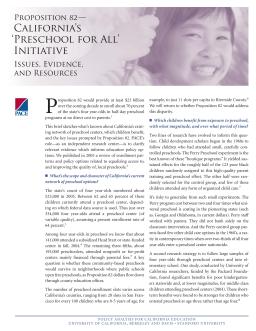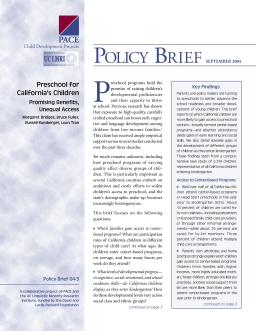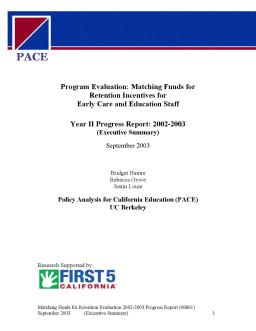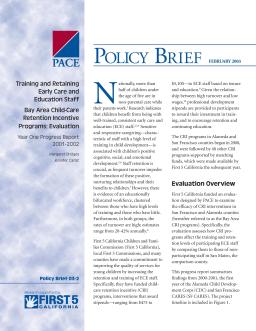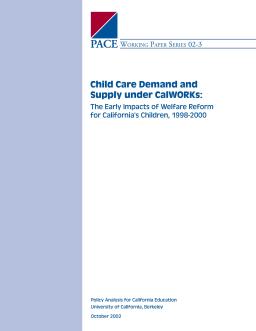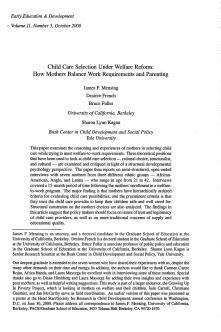School Finance and Governance in California
Published
Summary
Getting Down to Facts is an extensive investigation of CA's public education system commissioned by a bipartisan group of CA leaders. The project aimed to describe California's school finance and governance systems, identify obstacles hindering resource utilization, and estimate costs to achieve student outcome goals. The project resulted in 23 reports by scholars, which highlight that the current school finance and governance systems fail to help students achieve state performance goals, particularly those from low-income families. The reports provide a framework for assessing reform options.
Issues, Evidence, and Resources
Published
Summary
This brief provides an overview of California's existing network of preschool centers and the potential impact of Proposition 82, which would provide funding for half-day preschool programs for 70% of the state's four-year-olds. PACE, an independent research center, aims to clarify evidence informing education policy options. A 2005 PACE review focused on enrollment patterns and policy options for improving access and quality of local preschools.
Promising Benefits, Unequal Access
Published
Summary
This policy brief examines how California's education governance has shifted from local control to centralized, administrative accountability over the past 30 years, including changes in school finance. It primarily focuses on categorical program funding, assessing its impact on equity, adequacy, flexibility, choice, efficiency, predictability, stability, rationality, and accountability. The authors also propose alternative models to the existing system of categorical funding.
Year Two Progress Report, 2002–03—Executive Summary
Published
Summary
This report highlights findings from a 2002-03 progress report on First 5 California's childcare retention incentive programs, aimed at improving retention and increasing training among early care and education staff. Data were collected from ten counties through a phone survey of participants and site visits. Initial findings related to program design and implementation, program participation, training and professional development, and retention are summarized.
Bay Area Childcare Retention Incentive Programs Evaluation—Year One Progress Report, 2001–02
Published
Summary
The First 5 California Children and Families Commission has funded the Childcare Retention Incentive (CRI) to improve the quality of early care and education (ECE) staff training and retention. An evaluation funded by First 5 California assesses the efficacy of CRI programs in San Francisco and Alameda counties. This report summarizes the preliminary findings from the first year of the Alameda Child Development Corps and San Francisco CARES programs, which examine whether CRI recipients are more likely to participate in training and be retained compared to non-participating ECE staff.
Year One Progress Report, 2001–2002
Published
Summary
This policy brief examines the effectiveness of childcare retention incentive (CRI) programs in selected California counties. It assesses program design, participant characteristics, training activities, and retention rates among early care and education staff. The study aims to identify the impact of CRI programs on the stability and training of the ECE workforce, which is critical for improving the quality of care for children.
The Early Impacts of Welfare Reform for California's Children, 1998–2000
Published
Summary
This report examines the effects of welfare-to-work and childcare capacity building on the childcare system in California, prompted by changes in the childcare system and welfare reform. The study was requested by the California Department of Social Services, and this paper provides an overview of the findings.
Year 1—Qualitative Implementation Study
Published
Summary
This report provides guidance on implementing childcare retention initiatives based on Alameda County’s Child Development Corps program. PACE conducted focus groups with stakeholders to gather feedback on the planning and implementation process. The program saw increased commitment from providers to their profession and seeking training opportunities, but challenges remain with fitting permit requirements to family providers and relevance of courses.
How Mothers Balance Work Requirements and Parenting
Published
Summary
This paper examines how mothers select childcare to meet welfare-to-work requirements. Interviews with seven mothers from different ethnic groups show that trust in childcare providers to keep their children safe is the most important criterion. Structural constraints on their choices are also analyzed. The findings suggest that policymakers should focus on trust and legitimacy of childcare providers in addition to supply and educational quality.

